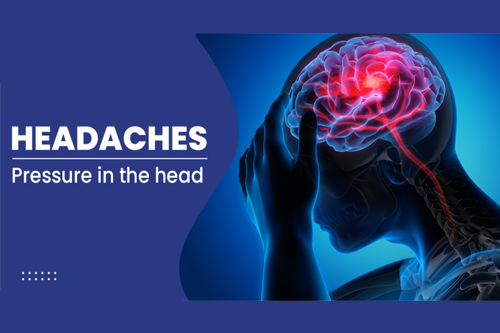
Headache disorders
Headaches are common and range in the type, intensity, and location of pain. Headaches are a major cause of absence from work or school and from visits to health care providers. Although generally not life-threatening, some types of headache may be indicative of a serious underlying medical problem.
Types of headache disorders
Other aetiologies causing public health concern include migraines, tension-type headaches, and medication-overuse headaches.
- Migraine: A headache recurrent or hemicranial lasting from 4 to 72 hours. There are usually accompanying symptoms including nausea, vomiting and hypersensitivity to light and sound. More women than men are afflicted. The onset typically begins at the onset of puberty and can continue throughout life. Triggers may include alcohol, certain foods.
- Tension-type headache (TTH): Described as pressure or tightness around the head, possibly stress-related or linked to neck issues. More common in women, this condition can be episodic, less than 15 days per month, or chronic.
- Cluster headache (CH): Characterized by severe, recurrent headaches focused around one eye and often accompanied by eye tearing and nasal congestion. More common in males, this can be either episodic or chronic.
- MOH: This condition is caused by an overuse of headache medications. Again, these complaints are predominantly upon women and sometimes even chronic in nature; however, their general symptoms worsen at waking.
Headache disorders are a pivotal cause of morbidity in society. Effective management strategies are highly essential for managing these headache disorders and having an impact on day-to-day activities.
1. Tension-Type Headaches (TTH)
- Symptoms: Mild to moderate pain, typically described as a tight band around the head or a dull, aching sensation.
- Duration: Can last from 30 minutes to several hours or even days.
- Triggers: Stress, poor posture, lack of sleep, or eye strain.
- Treatment: Over-the-counter pain relievers (ibuprofen, acetaminophen), relaxation techniques, and lifestyle changes.
2. Migraine
- Symptoms: Severe, throbbing headache often on one side of the head, with associated symptoms like nausea, vomiting, sensitivity to light (photophobia),
- sound (phonophobia), and sometimes visual disturbances (auras).
- Duration: Migraines can last from the 4 to 72 hours.
- Triggers: Hormonal changes, stress, certain foods, bright lights, loud sounds, and weather changes.
- Treatment: Medications like triptans, anti-nausea drugs, and preventive treatments (beta-blockers, antidepressants, anticonvulsants). Lifestyle adjustments or avoiding triggers are also important.
3. Cluster Headaches
- Symptoms: Excruciating, stabbing pain usually centered around one eye, often accompanied by redness, tearing, nasal congestion, or runny nose on the affected side.
- Duration: Short, intense bouts lasting 15 minutes to 3 hours, occurring in “clusters” over a period of weeks or months.
- Triggers: Alcohol, smoking, seasonal changes, and high altitudes.
- Treatment: Oxygen therapy, triptans, preventive medications (like verapamil), and nerve blocks.
4. Chronic Daily Headaches
- Symptoms: Headaches occurring 15 or more days a month for more than 3 months. These headaches can be a combination of tension-type headaches and migraines.
- Causes: Overuse of pain medications, stress, or underlying medical conditions.
- Treatment: Breaking the cycle of medication overuse, preventive therapy, lifestyle changes, and addressing underlying causes.
5. Medication Overuse Headaches (Rebound Headaches)
- Symptoms: Headaches that worsen over time due to the overuse of pain-relieving medications. They often start in the morning and recur throughout the day.
- Causes: Overuse of over-the-counter or prescription headache medications (more than 2-3 times per week).
- Treatment: Gradual reduction or cessation of the overused medication under medical supervision and switching to preventive treatments.
6. Sinus Headaches
- Symptoms: Deep, constant pain in the cheekbones, forehead, or bridge of the nose, often associated with sinus congestion, runny nose, and fever.
- Causes: Inflammation or infection of the sinuses.
- Treatment: Treating the underlying sinus condition with decongestants, antibiotics (if bacterial), and pain relievers.
7. Hormonal Headaches
- Symptoms: Migraines or tension-type headaches associated with hormonal fluctuations, commonly occurring around menstruation (menstrual migraines), pregnancy, or menopause.
- Causes: Changes in estrogen levels.
- Treatment: Hormonal therapy, preventive medications, and lifestyle management.
Diagnosis of Headache Disorders:
- History and Symptoms: A detailed description of headache type, frequency, duration, and associated symptoms.
- Imaging: MRI or CT scans may be used to rule out other conditions (e.g., brain tumors, aneurysms).
- Blood Tests: In cases where infections or metabolic disorders are suspected.
Treatment Strategies:
- Acute Treatment: Pain relievers (NSAIDs, acetaminophen, triptans, or ergotamines for migraines).
- Preventive Treatment: Beta-blockers, anticonvulsants, antidepressants, and Botox injections.
- Lifestyle Adjustments: Stress management, regular sleep, hydration, and avoiding known triggers.
- Alternative Therapies: Acupuncture, biofeedback, and cognitive-behavioral therapy (CBT) have been shown to help in some cases.
Treatment
Proper diagnosis, education and training of the health care providers, and patient education are the crux of the proper treatment for headache disorders. Medication, lifestyle modification, and identification of cause or triggers are some significant areas of treatment for headache disorder. There are several medicines used in headache treatments, including analgesics, anti-emetics, and specific drugs for migraines and prophylactic medicines. Monitoring the headache, maintaining good habits by avoiding triggering agents, and taking analgesics at an early time of onset contribute quite a bit in headache disorder management.
Treatments vary by type of headache. A headache diary would help determine what triggers headaches. Once triggers are determined, then treatment plans can be developed for each individual. Counseling and guidance on stress management may be necessary for headaches due to stress. Treatment strategies can include stress management, biofeedback, medication, and treatment of a medical condition that may be causing the headaches. Medication may not be necessary since a few treatments could be tailored to the individual.
At our Neurosys Multispeciality Center, we perform several key procedures including Craniotomy, which is primarily for the excision of brain tumors; V-P Shunt Surgery for treating hydrocephalus; surgeries for epilepsy; and operations targeting brain stem glioma. Beyond these, we offer a range of other neurosurgical services. If you have any questions that are not answere, please contact us through our Contact Us or Book your Appointment.
